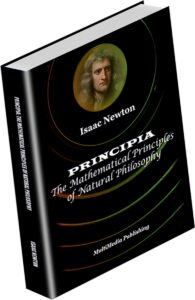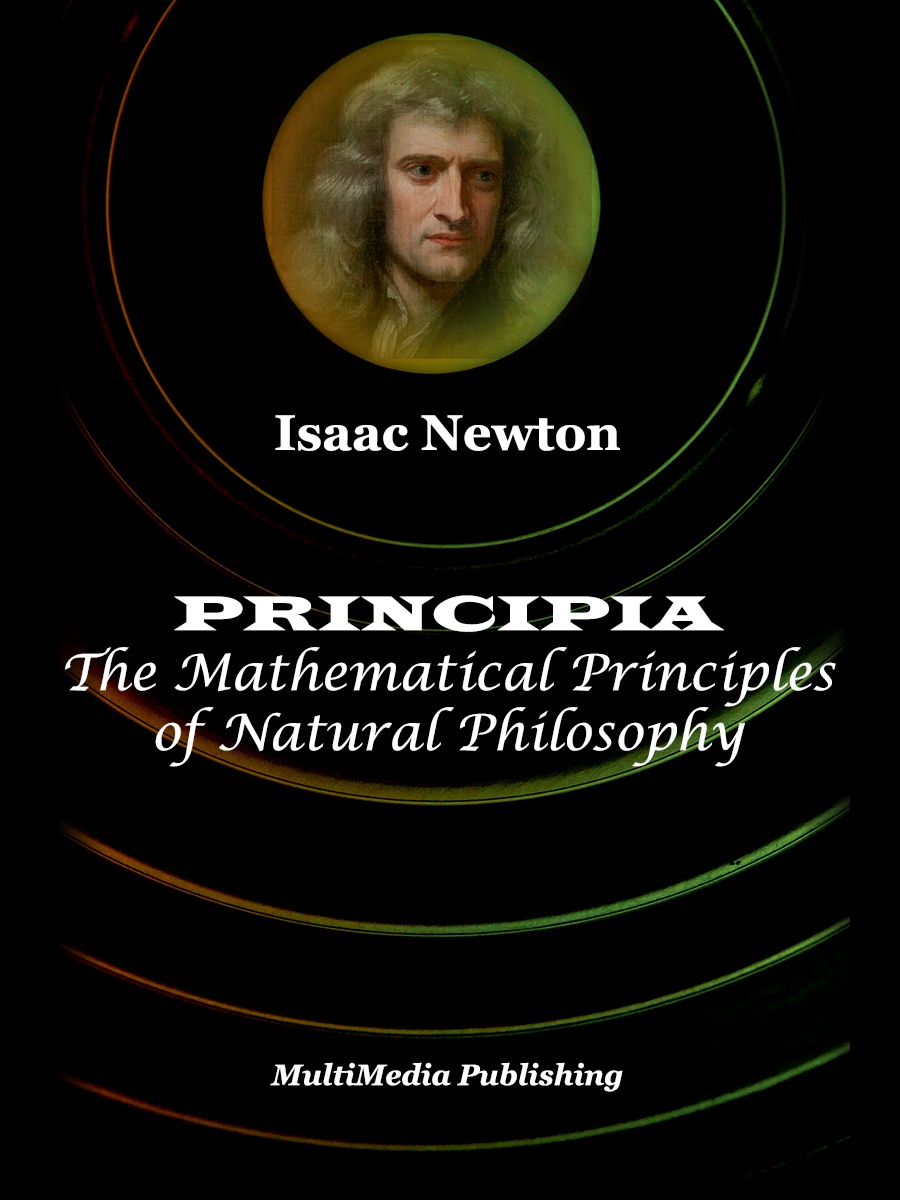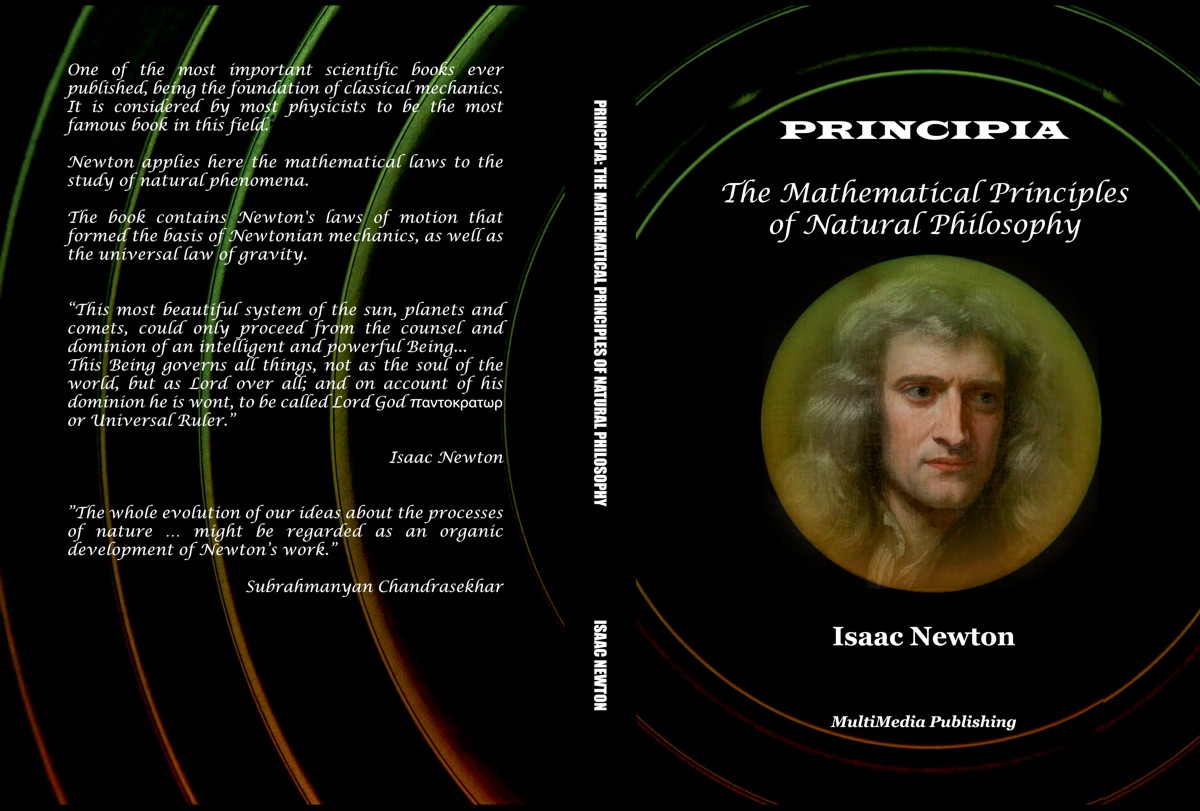 The Mathematical Principles of Natural Philosophy, by Isaac Newton (1642 – 1727)
The Mathematical Principles of Natural Philosophy, by Isaac Newton (1642 – 1727)
Translated into English by Andrew Motte (1693 – 1728)
Published by Daniel Adee, 1846. Edited by N. W. Chittenden
Addendum, by Nicolae Sfetcu:
– Historical context: Action at a distance
– The methodology of Isaac Newton
– The dispute over the priority of the law of gravity
Cover: Portrait of Isaac Newton (1642-1727), by Godfrey Kneller (1646–1723), oil on canvas, 1689, Collection Isaac Newton Institute (cropped and processed)
The Mathematical Principles of Natural Philosophy (Latin: “Philosophiae naturalis principia mathematica“), often abbreviated as Principia or Principia Mathematica, the Isaac Newton’s masterpiece, was published in London on July 5, 1687. The text of the third edition in Latin, 1726 , will be revised and enriched for the last time by Newton, being generally considered as a reference. The book is one of the most important scientific books ever published, being the foundation of classical mechanics. It is considered by most physicists to be the most famous book in this field. Newton applies here the mathematical laws to the study of natural phenomena. The book contains Newton’s laws of motion that formed the basis of Newtonian mechanics, as well as the universal law of gravity.
Most translations of the book are based on Newton’s third edition in 1726. The first translation, in 1729, belongs to Andrew Motte, republished in 1846 by Daniel Adee as the first American edition, edited by N. W. Chittenden.
The book begins with definitions, laws, or axioms, followed by three parts (or “books”) about “the motion of bodies” and “the system of the world.”
“This most beautiful system of the sun, planets and comets, could only proceed from the counsel and dominion of an intelligent and powerful Being… This Being governs all things, not as the soul of the world, but as Lord over all; and on account of his dominion he is wont, to be called Lord God παντοκρατωρ or Universal Ruler.” (Isaac Newton)
”The whole evolution of our ideas about the processes of nature … might be regarded as an organic development of Newton’s work.” (Subrahmanyan Chandrasekhar)
CONTENTS:
Dedication.
Iintroduction to the American edition.
Life of Sir Isac Newton.
The author preface
Book I.
– Definitions.
– – Definition I.
– – Definition II.
– – Definition III.
– – Definition IV.
– – Definition V.
– – Definition VI.
– – Definition VII.
– – Definition VIII.
– – Scholium.
– Axioms, or laws of motion.
– – Law I.
– – Law II.
– – Law III.
– – Corolary I.
– – Corolary II.
– – Corolary III.
– – Corolary IV.
– – Corolary V.
– – Corolary VI.
– – Scholium.
Of the motion of bodies.
– Section I. Of the method of first and last ratios of quantities, by the help whereof we demonstrate the Propositions that follow
– – Lemma I.
– – Lemma II.
– – Lemma III.
– – Lemma IV.
– – Lemma V.
– – Lemma VI.
– – Lemma VII.
– – Lemma VIII.
– – Lemma IX.
– – Lemma X.
– – Scholium.
– – Lemma XI.
– – Scholium.
– Section II. Of the Invention of Centripetal Forces
– – Proposition I. Theorem I.
– – Proposition II. Theorem II.
– – Scholium.
– – Proposition III. Theorem III.
– – Scholium.
– – Proposition IV. Theorem IV.
– – Scholium.
– – Proposition V. Problem I.
– – Proposition VI. Theorem V.
– – Proposition VII. Problem II.
– – Proposition VIII. Problem III.
– – Scholium.
– – Proposition IX. Problem IV.
– – Lemma XII.
– – Proposition X. Problem V.
– – Scholium.
– Section III. Of the motion of bodies in eccentric conic Sections
– – Proposition XI. Problem VI.
– – Proposition XII. Problem VII.
– – Lemma XIII.
– – Lemma XIV.
– – Proposition XIII. Problem VIII.
– – Proposition XIV. Theorem VI.
– – Proposition XV. Theorem VII.
– – Proposition XVI. Theorem VIII.
– – Proposition XVII. Problem IX.
– – Scholium.
– Section IV. Of the finding of elliptic, parabolic, and hyperbolic orbits, from the focus given
– – Lemma XV.
– – Proposition XVIII. Problem X.
– – Proposition XIX. Problem XI.
– – Proposition XX. Problem XII.
– – Lemma XVI.
– – Proposition XXI. Problem XIII.
– – Scholium.
– Section V. How the orbits are to be found when neither focus is given
– – Lemma XVII.
– – Lemma XVIII.
– – Scholium.
– – Lemma XIX.
– – Lemma XX.
– – Lemma XXI.
– – Proposition XXII. Problem XIV.
– – Scholium.
– – Proposition XXIII. Problem XV.
– – Proposition XXIV. Problem XVI.
– – Lemma XXII.
– – Proposition XXV. Problem XVII.
– – Proposition XXVI. Problem XVIII.
– – Lemma XXIII.
– – Lemma XXIV.
– – Lemma XXV.
– – Proposition XXVII. Problem XIX.
– – Scholium.
– – Lemma XXVI.
– – Proposition XXVIII. Problem XX.
– – Lemma XXVII.
– – Proposition XXIX. Problem XXI.
– – Scholium.
– Section VI. How the motions are to be found in given orbits
– – Proposition XXX. Problem XXII.
– – Lemma XXVIII.
– – Proposition XXXI. Problem XXIII.
– – Scholium.
– Section VII. Concerning the rectilinear ascent and descent of bodies
– – Proposition XXXII. Problem XXIV.
– – Proposition XXXIII. Theorem IX.
– – Proposition XXXIV. Theorem X.
– – Proposition XXXV. Theorem XI.
– – Proposition XXXVI. Problem XXV.
– – Proposition XXXVII. Problem XXVI.
– – Proposition XXXVIII. Theorem XII.
– – Proposition XXXIX. Problem XXVII.
– Section VIII. Of the invention of orbits wherein bodies will revolve, being acted upon by any sort of centripetal force
– – Proposition XL. Theorem XIII.
– – Proposition XLI. Problem XXVIII.
– – Proposition XLII. Problem XXIX.
– Section IX. Of the motion of bodies in moveable orbits; and of the motion of the apsides
– – Proposition XLIII. Problem XXX.
– – Proposition XLIV. Theorem XIV.
– – Proposition XLV. Problem XXXI.
– Section X. Of the motion of bodies in given superficies, and of the reciprocal motion of funependulous bodies
– – Proposition XLVI. Problem XXXII.
– – Proposition XLVII. Theorem XV.
– – Scholium.
– – Proposition XLVIII. Theorem XVI.
– – Proposition XLIX. Theorem XVII.
– – Proposition L. Problem XXXIII.
– – Proposition LI. Theorem XVIII.
– – Proposition LII. Problem XXXIV.
– – Proposition LIII. Problem XXXV.
– – Proposition LIV. Problem XXXVI.
– – Proposition LV. Theorem XIX.
– – Proposition LVI. Problem XXXVII.
– Section XI. Of the motions of bodies tending to each other with centripetal forces
– – Proposition LVII. Theorem XX.
– – Proposition LVIII. Theorem XXI.
– – Proposition LIX. Theorem XXII.
– – Proposition LX. Theorem XXIII.
– – Proposition LXI. Theorem XXIV.
– – Proposition LXII. Problem XXXVIII.
– – Proposition LXIII. Problem XXXIX.
– – Proposition LXIV. Problem XL.
– – Proposition LXV. Theorem XXV.
– – Proposition LXVI. Theorem XXVI.
– – Proposition LXVII. Theorem XXVII.
– – Proposition LXVIII. Theorem XXVIII.
– – Proposition LXIX. Theorem XXIX.
– – Scholium.
– Section XII. Of the attractive forces of sphærical bodies
– – Proposition LXX. Theorem XXX.
– – Proposition LXXI. Theorem XXXI.
– – Proposition LXXII. Theorem XXXII.
– – Proposition LXXIII. Theorem XXXIII.
– – Scholium.
– – Proposition LXXIV. Theorem XXXIV.
– – Proposition LXXV. Theorem XXXV.
– – Proposition LXXVI. Theorem XXXVI.
– – Proposition LXXVII. Theorem XXXVII.
– – Proposition LXXVIII. Theorem XXXVIII.
– – Scholium.
– – Lemma XXIX.
– – Proposition LXXIX. Theorem XXXIX.
– – Proposition LXXX. Theorem XL.
– – Proposition LXXXI. Problem XLI.
– – Proposition LXXXII. Theorem XLI.
– – Proposition LXXXIII. Problem XLII.
– – Proposition LXXXIV. Problem XLIII.
– – Scholium.
– Section XIII. Of the attractive forces of bodies which are not of a sphærical figure
– – Proposition LXXXV. Theorem XLII.
– – Proposition LXXXVI. Theorem XLIII.
– – Proposition LXXXVII. Theorem XLIV.
– – Proposition LXXXVIII. Theorem XLV.
– – Proposition LXXXIX. Theorem XLVI.
– – Proposition XC. Problem XLIV.
– – Proposition XCI. Problem XLV.
– – Proposition XCII. Problem XLVI.
– – Proposition XCIII. Theorem XLVII.
– – Scholium.
– Section XIV. Of the motion of very small bodies when agitated by centripetal forces tending to the several parts of any very great body
– – Proposition XCIV. Theorem XLVIII.
– – Proposition XCV. Theorem XLIX.
– – Proposition XCVI. Theorem L.
– – Scholium.
– – Proposition XCVII. Problem XLVII.
– – Proposition XCVIII. Problem XLVIII.
– – Scholium.
Book II.
– Section I. Of the motion of bodies that are resisted in the ratio of the velocity
– – Proposition I. Theorem I.
– – Lemma I.
– – Proposition II. Theorem II.
– – Proposition III. Problem I.
– – Proposition IV. Problem II.
– – Scholium.
– Section II. Of the motion of bodies that are resisted in the duplicate ratio of their velocities
– – Proposition V. Theorem III.
– – Proposition VI. Theorem IV.
– – Proposition VII. Theorem V.
– – Lemma II.
– – Scholium.
– – Proposition VIII. Theorem VI.
– – Proposition IX. Theorem VII.
– – Scholium.
– Section III. Of the motions of bodies which are resisted partly in the ratio of the velocities, and partly in the duplicate of the same ratio
– – Proposition XI. Theorem VIII.
– – Proposition XII. Theorem IX.
– – Proposition XIII. Theorem X.
– – Scholium
– – Proposition XIV. Theorem XI.
– – Scholium.
– Section IV. Of the circular motion of bodies in resisting mediums
– – Lemma III.
– – Proposition XV. Theorem XII.
– – Proposition XVI. Theorem XIII.
– – Scholium.
– – Proposition XVII. Problem IV.
– – Proposition XVIII. Problem V.
– Section V. Of the density and compression of fluids; and of hydrostatics
– – The Definition OF A FLUID.
– – Proposition XIX. Theorem XIV
– – Proposition XX. Theorem XV.
– – Proposition XXI. Theorem XVI.
– – Proposition XXII. Theorem XVII.
– – Scholium.
– – Proposition XXIII. Theorem XVIII.
– – Scholium.
– Section VI. Of the motion and resistance of funependulous bodies
– – Proposition XXIV. Theorem XIX.
– – Proposition XXV. Theorem XX.
– – Proposition XXVI. Theorem XXI.
– – Proposition XXVII. Theorem XXII.
– – Proposition XXVIII. Theorem XXIII.
– – Proposition XXIX. Problem VI.
– – Proposition XXX. Theorem XXIV.
– – Proposition XXXI. Theorem XXV.
– – GENERAL Scholium.
– Section VII. Of the motion of fluids, and the resistance made to projected bodies
– – Proposition XXXII. Theorem XXVI.
– – Proposition XXXIII. Theorem XXVII.
– – Proposition XXXIV. Theorem XXVIII.
– – Scholium.
– – Proposition XXXV. Problem VII.
– – Scholium.
– – Proposition XXXVI. Problem VIII.
– – Lemma IV.
– – Proposition XXXVII. Theorem XXIX.
– – Scholium.
– – Lemma V.
– – Lemma VI.
– – Lemma VII.
– – Scholium.
– – Proposition XXXVIII. Theorem XXX.
– – Proposition XXXIX. Theorem XXXI.
– – Scholium.
– – Proposition XL. Problem IX.
– – Scholium.
– Section VIII. Of motion propagated through fluids
– – Proposition XLI. Theorem XXXII.
– – Proposition XLII. Theorem XXXIII.
– – Proposition XLIII. Theorem XXXIV.
– – Proposition XLIV. Theorem XXXV.
– – Proposition XLV. Theorem XXXVI.
– – Proposition XLVI. Problem X.
– – Proposition XLVII. Theorem XXXVII.
– – Proposition XLVIII. Theorem XXXVIII.
– – Proposition XLIX. Problem XI.
– – Proposition L. Problem XII.
– – Scholium.
– Section IX. Of the circular motion of fluids
– – Hypothesis.
– – Proposition LI. Theorem XXXIX.
– – Proposition LII. Theorem XL.
– – Scholium.
– – Proposition LIII. Theorem XLI.
– – Scholium.
Book III.
– Rules of reasoning in philosophy.
– – Rule I.
– – Rule II.
– – Rule III.
– – Rule IV.
– Phænomena, or appearances.
– – Phænomenon I.
– – Phænomenon II.
– – Phænomenon III.
– – Phænomenon IV.
– – Phænomenon V.
– – Phænomenon VI.
– PropositionS I-IX (Force of gravity)
– – Proposition I. Theorem I.
– – Proposition II. Theorem II.
– – Proposition III. Theorem III.
– – Proposition IV. Theorem IV.
– – Scholium.
– – Proposition V. Theorem V.
– – Scholium.
– – Proposition VI. Theorem VI.
– – Proposition VII. Theorem VII.
– – Proposition VIII. Theorem VIII.
– – Proposition IX. Theorem IX.
– PropositionS X-XXIV (Motions of celestial bodies and the sea)
– – Proposition X. Theorem X.
– – Hypothesis I.
– – Proposition XI. Theorem XI.
– – Proposition XII. Theorem XII.
– – Proposition XIII. Theorem XIII.
– – Proposition XIV. Theorem XIV.
– – Scholium.
– – Proposition XV. Problem I.
– – Proposition XVI. Problem II.
– – Proposition XVII. Theorem XV.
– – Proposition XVIII. Theorem XVI.
– – Proposition XIX. Problem III.
– – Proposition XX. Problem IV.
– – Proposition XXI. Theorem XVII.
– – Proposition XXII. Theorem XVIII.
– – Proposition XXIII. Problem V.
– – Proposition XXIV. Theorem XIX.
– PropositionS XXV-XXXIII (Quantity of lunar motions)
– – Proposition XXV. Problem VI.
– – Proposition XXVI. Problem VII.
– – Proposition XXVII. Problem VIII.
– – Proposition XXVIII. Problem IX.
– – Proposition XXIX. Problem X.
– – Proposition XXX. Problem XI.
– – Proposition XXXI. Problem XII.
– – Proposition XXXII. Problem XIII.
– – Proposition XXXIII. Problem XIV.
– – Scholium.
– OF THE MOTION OF THE MOON’S NODES.
– – “Proposition I.
– – “Proposition II.
– – “Scholium.
– – Proposition XXXIV. Problem XV.
– – Proposition XXXV. Problem XVI.
– – Scholium.
– PropositionS XXXVI-XXXVIII (Forces to move the sea)
– – Proposition XXXVI. Problem XVII.
– – Proposition XXXVII. Problem XVIII.
– – Proposition XXXVIII. Problem XIX.
– LemmaS I-III, Proposition XXXIX (Precession of equinoxes)
– – Lemma I.
– – Lemma II.
– – Lemma III.
– – Hypothesis II.
– – Proposition XXXIX. Problem XX.
– LemmaS IV-XI, PropositionS XL-XLII (Comets)
– – Lemma IV.
– – Proposition XL. Theorem XX.
– – Lemma V.
– – Lemma VI.
– – Lemma VII.
– – Lemma VIII.
– – Scholium.
– – Lemma IX.
– – Lemma X.
– – Lemma XI.
– – Proposition XLI. Problem XXI.
– – Proposition XLII. Problem XXII.
– General Scholium.
The system of the world.
– Problem.
– Lemma I.
– Lemma II.
– Lemma III.
– Lemma IV.
– Lemma V.
– Problem I.
Addendum
– Historical context: Action at a distance
– – Introduction
– – Principia
– – Correspondence with Richard Bentley
– – Queries in Opticks
– – Conclusions
– The methodology of Isaac Newton
– – The methodology
– – The heuristics
– – The tests
– – The anomalies
– – The end
– The dispute over the priority of the Law of gravity
– – Introduction
– – Robert Hooke’s contribution to the Law of universal gravitation
– – Isaac Newton’s contribution to the Law of universal gravitation
– – Robert Hooke’s claim of his priority on the Law of universal gravitation
– – Newton’s defense
– – The controversy in the opinion of other contemporary scientists
– – What the supporters of Isaac Newton say
– – What the supporters of Robert Hooke say
– – Conclusions
– Notes
– Bibliography
– Publishing House
– MultiMedia Publishing
MultiMedia Publishing
– Digital: EPUB (ISBN 978-606-033-647-1), Kindle (ISBN 978-606-033-648-8), PDF (ISBN 978-606-033-649-5)
Data publicării:
PREVIEW:
Amazon (Print, Kindle) https://www.amazon.com/dp/B09M5LJZND https://www.amazon.com/dp/B09M95G31T
Smashwords (EPUB): https://www.smashwords.com/books/view/1116335
Google (EPUB, PDF): https://books.google.ro/books?id=FglQEAAAQBAJ
Facebook:
YouTube:












Reviews
There are no reviews yet.